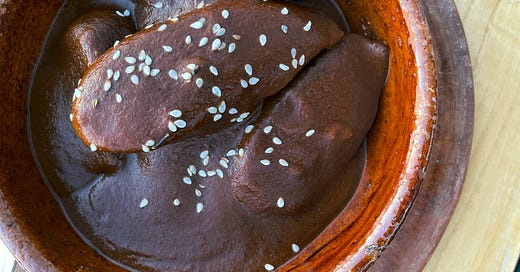Mole is sweet in Guatemala. I don’t mean sweet like a mole Poblano or a mole almendrado. It’s not a sweet sauce for a savory course, but rather a sweet sauce for a sweet course.
Guatemalan mole stretches the definition of the already barely definable concept of moles. In Mexico, many think of the seven classic moles of Oaxaca’s Valle Central, but that is only a fraction of what exists when the word is spoken. There are hundreds of them, if not thousands, both pre-Columbian and post colonial. They can be made from mushrooms or squash blossoms and cut with turkey broth. New ones are being created all the time. They are a base of chiles with many other ingredients – more than 20 or 30 in some cases, like in Oaxaca’s mole negro – all ground on a metate, then mixed and heated together so not any single ingredient stands out.
Thalia Barrios García’s Mole de Hongos
Mole, which I wrote about for Eater earlier in the year, is a rather misunderstood concept in Mexican cuisine. Much of what gets defined as mole are the classic moles of the Oaxaca Valley. These are the mestizo moles born in and around Oaxaca city, a collection of ingredients both native and f…
In Guatemala, if you say mole, it’s almost always referring to plátanos en mole (also called mole de plátano). That’s ripe plantains, fried in oil, then covered in mole. While there are chiles used in the recipe, they are less pronounced. Proportion wise, they do not dominate, like some Mexican moles do. Their spice is just a reminder, perhaps. They are ground on the metate, as are other native ingredients like tomatoes and squash seeds. Like those better-known moles of Mexico, it’s a colonial concoction, dating to the sixteenth century, where imported ingredients like sesame seeds and cinnamon, plus chocolate, add flavor too.
Keep reading with a 7-day free trial
Subscribe to New Worlder to keep reading this post and get 7 days of free access to the full post archives.





